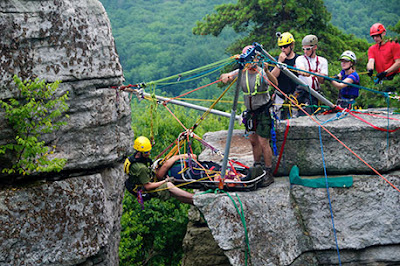Construction and maintenance jobs are
not the only times a high angle rescue or mid-height pick technique will be
used. Hiking, rock climbing, and utility repair are just a few instances when a
rescue team may have to prepare for a limited access rescue situation.
Assessing the Situation
When you receive the call that a
person has fallen or slipped from a dangerous height, the first thing you must
do is assess the situation, minimize any potential risks and start to set up
the rescue operation. You need to identify any possible obstructions that will
hamper the rescue effort. These include:
● The cause of the accident
● Sharp edges that may cut or
damage your equipment
● Turn off any utilities that
may hinder the rescue, this includes the electricity if a power line is
involved
● Determine if the victim is
unconscious or injured
● Is the area stable enough to
support a high angle rescue
All of these situations must be
addressed prior to setting up the technical rescue equipment to prevent additional injuries to
rescue workers or damage to the equipment. You will need to assess the
situation quickly and efficiently, allowing the victim to receive the medical
attention they need as soon as possible.
Determine the Best Rescue
Depending on the height of the victim
and the environment where they are located, you will have to choose the
appropriate rope rescue technique for the job. If the victim is
conscious, they will be able to assist your efforts. If they are unconscious,
you will have to stabilize them and use a basket to raise or lower them to
safety.
If you are in a position to safely
lower the basket assembly to the ground. This is often the best scenario as it
gives EMT/paramedics immediate access to the victim. In situations where the
victim's location is not close enough to the ground, the basket may need to be
raised and the victim retrieved in that manner.
Assemble Your Crews and the Equipment
If a ground rescue is a viable
option, crew members will have to be at the top to guide the equipment and
rescue team down to the victim. Another team must be on the ground, ready to
release the basket and transport the victim to a staging area where EMT and
paramedics are waiting. For most rescue scenarios, you will need the following
items:
● Full harness and rigging for
each crew member
● Rigging and basket for victim
● Extra D-rings, hooks, and
straps
● Multiple pulley systems
depending on the angle and location of the rescue
● Multiple crew members who can
be placed as needed
● Stabilizing ballast, if
nothing is present that is suitable for use.
If a high angle rescue is performed
when there is no way to safely lower the victim, you will need to prepare a
rescue pick or lift. It's important to remember that if the victim was using
any type of rigging system, such as a cable and winch, you will need to find
out if it is still operational. If so, using it will enable you to lift the
victim back to safety without removing any of their equipment. If their
equipment is damaged in any way, avoid using it and perform a full rescue
operation using your own equipment. If a victim has fallen and has no equipment
to speak of you will have to use your own. Using a basket is acceptable, even
if the victim is conscious and able to help. In this case, stabilizing them in
a basket set up may be beneficial and avoid further injury.
High angle
rescues involve moderate to high risks, especially if the victim needs to
be lifted back to the original point of descent. It's important to re-check the
stability of your system throughout the rescue process to ensure that everything
remains secure and continues to function efficiently. For more in-depth training when it comes to rope rescues, contact either
AHSRescue.com or Ropes That Rescue today for rescue
classes and workshops all over the U.S.!
“The above published blog post content is a reference of
originally published @ https://roperescueequipmentsupplier.weebly.com/blog/determining-if-a-high-angle-rescue-is-needed”


Comments
Post a Comment